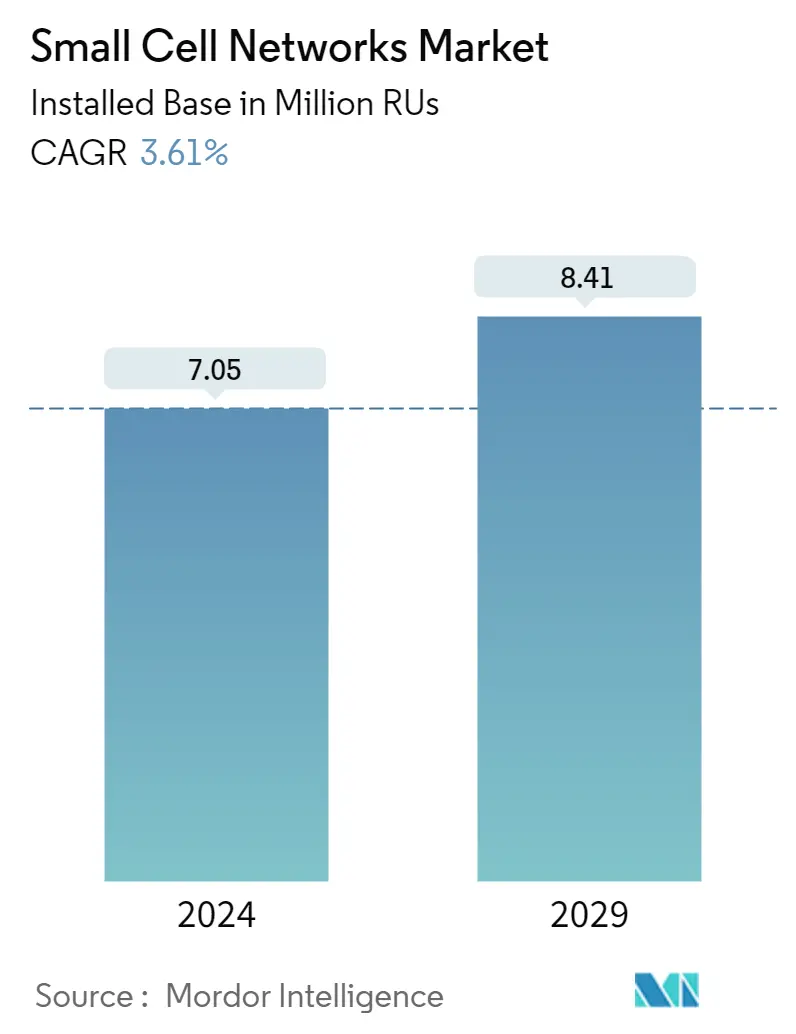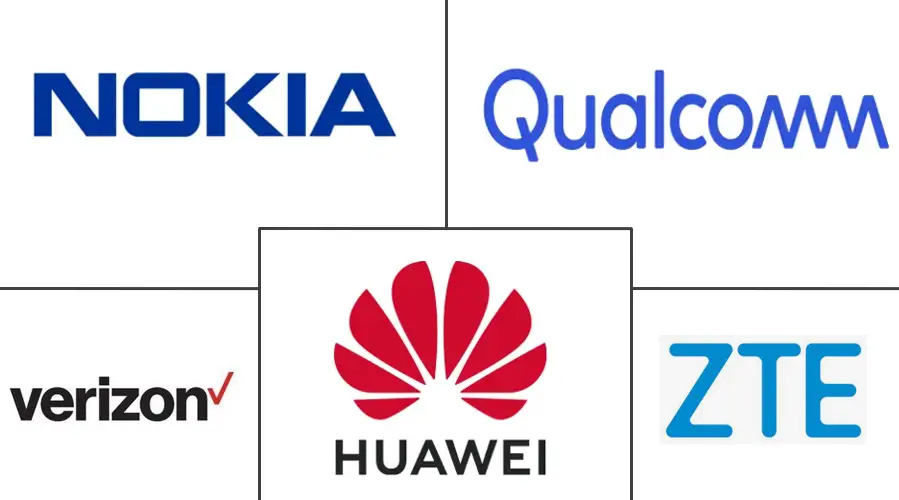Market Size of Small Cell Networks Industry

| Study Period | 2019 - 2029 |
| Base Year For Estimation | 2023 |
| CAGR (2024 - 2029) | 3.61 % |
| Fastest Growing Market | Asia-Pacific |
| Largest Market | North America |
| Market Concentration | Low |
Major Players
*Disclaimer: Major Players sorted in no particular order |
Small Cell Networks Market Analysis
The Small Cell Networks Market size in terms of installed base is expected to grow from 7.05 Million RUs in 2024 to 8.41 Million RUs by 2029, at a CAGR of 3.61% during the forecast period (2024-2029).
The deployment of the next-generation radio access network has expanded due to consumers' suddenly rising need for fast mobile data connectivity. Small cell network installation is expanding across commercial, residential, and industrial applications to offer better coverage at a lower cost.
- Rising mobile data traffic has caused telecom companies to move toward network densification to provide mass consumers with high-speed capacity. Due to the rise of smart cities, especially in developed economies like the U.S., Canada, Singapore, the UK, Germany, Italy, and France, more small cell 5G networks are being set up for residential, commercial, government, and industrial use.
- Further, the rapidly growing smart home and connected IoT devices shape the need for the internet differently. Several smart home features, like controlling the water supply, keeping an eye on the electricity, and having voice-activated security systems, are just the beginning of what connected devices can do. For a seamless experience, these devices need to be connected to the internet all the time and at a high speed.
- Statistics on user behavior have indicated that indoor user connections increasingly use traditional short-range unlicensed spectrum technologies, like Wi-Fi. Such devices are mainly applied to indoor scenarios, which makes them beneficial for starting the convergence spectrum. Thus, spectrum convergence through a small cell network allows for network planning and utilizing the unlicensed spectrum range more efficiently. Moreover, manufacturers of small cells are observing an increased implementation among in-building applications. For example, Ericsson collaborated with China Unicom to deploy the Radio Dot System at over 500 commercial and residential buildings in Beijing.
- Several significant countries are investing heavily in the deployment of virtualized small cell 5G network infrastructure by major telecom providers. For instance, Mavenir announced the introduction of high-capacity 5G small cell in-building independent coverage for businesses and public areas in September 2022. The 5G small cell's versatility allows for both distributed and centralized end-to-end open radio access network (ORAN) architectures.The company's ORAN technology provides end customers in manufacturing, retail, public spaces, and warehouses with a high-capacity, simple-to-deploy, and affordable solution.
- The world is still recovering from COVID-19 and has extensive internet usage, indicating the need for a whole new scale of data transfer rates. Recent adaptations of telemedicine, online education, and teleconferencing for work-from-home concepts must be fixed due to a lack of internet infrastructure. According to ASSIA, Inc., due to the COVID-19 pandemic, there was an 80% increase in PC and smartphone upload traffic since the beginning of March in the United States, with webcams, laptops, and PCs running video streams all the time.
Small Cell Networks Industry Segmentation
Small cells are usually used in places with a lot of people, like shopping malls, city centers, sports venues, airports, train stations, housing complexes, etc., where there are a lot of people.
The Small Cell Networks Market is Segmented by Operating Environment (Indoor, Outdoor), End-user Vertical (BFSI, IT and Telecom, Healthcare, Retail, Power & Energy), and Geography (North America (United States, Canada), Europe (Germany, UK, France, Spain, and Rest of Europe), Asia Pacific (China, Japan, India, Australia, and Rest of Asia-Pacific), and Latin America (Brazil, Mexico, Argentina, and Rest of Latin America), and Middle East & Africa (UAE, Saudi Arabia, South Africa, and Rest of MEA). The market sizes and forecasts are provided in terms of value (USD million) for all the above segments.
| Operating Environment | |
| Indoor | |
| Outdoor |
| End-user Industry | |
| BFSI | |
| IT and Telecom | |
| Healthcare | |
| Retail | |
| Power and Energy | |
| Other End-user Verticals |
| Geography | |||||||
| |||||||
| |||||||
| |||||||
| |||||||
|
Small Cell Networks Market Size Summary
The small cell networks market is poised for significant growth, driven by the increasing demand for fast mobile data connectivity and the expansion of next-generation radio access networks. This growth is facilitated by the deployment of small cell networks across various sectors, including commercial, residential, and industrial applications, which offer enhanced coverage at reduced costs. The rise of smart cities, particularly in developed regions, is further propelling the adoption of small cell 5G networks. These networks are essential for supporting the burgeoning number of smart home and IoT devices that require constant, high-speed internet connectivity. The convergence of spectrum through small cell networks is also optimizing network planning and utilization, particularly in indoor settings where traditional short-range technologies like Wi-Fi are prevalent.
The market is characterized by intense competition among major players such as Nokia Networks, Qualcomm Technologies Inc., Cisco Systems Inc., and Huawei Technologies Co. Ltd., who are continually innovating and forming strategic partnerships to enhance their market presence. The Asia-Pacific region is expected to experience the fastest growth due to the rapid adoption of mobile devices and the strengthening of 5G infrastructure by telecom companies. Collaborations and trials in this region, such as those involving Ericsson, Qualcomm, and Asia Pacific Telecom, highlight the potential of small cell networks to transform the telecom industry. The ongoing development and deployment of 5G small cell solutions, supported by global partnerships and technological advancements, underscore the industry's transition from 4G to 5G, promising improved connectivity and bandwidth capabilities.
Small Cell Networks Market Size - Table of Contents
-
1. MARKET DYNAMICS
-
1.1 Market Overview
-
1.2 Industry Value Chain Analysis
-
1.3 Industry Attractiveness - Porter's Five Forces Analysis
-
1.3.1 Threat of New Entrants
-
1.3.2 Bargaining Power of Buyers/Consumers
-
1.3.3 Bargaining Power of Suppliers
-
1.3.4 Threat of Substitute Products
-
1.3.5 Intensity of Competitive Rivalry
-
-
1.4 Impact of COVID-19 on the Market
-
1.5 Market Drivers
-
1.5.1 Evolution of Network Technology and Connectivity Devices
-
1.5.2 Rising Demand for Mobile Devices
-
1.5.3 Growth in IT and Telcom Sector to drive the overall market
-
-
1.6 Market Restraints
-
1.6.1 Increased Need for Managing Network
-
-
1.7 Technology Snapshot
-
1.7.1 Femtocell
-
1.7.2 Picocell
-
1.7.3 Microcell
-
1.7.4 Metrocell
-
1.7.5 Radio Dot Systems
-
-
-
2. MARKET SEGMENTATION
-
2.1 Operating Environment
-
2.1.1 Indoor
-
2.1.2 Outdoor
-
-
2.2 End-user Industry
-
2.2.1 BFSI
-
2.2.2 IT and Telecom
-
2.2.3 Healthcare
-
2.2.4 Retail
-
2.2.5 Power and Energy
-
2.2.6 Other End-user Verticals
-
-
2.3 Geography
-
2.3.1 North America
-
2.3.1.1 United States
-
2.3.1.2 Canada
-
-
2.3.2 Europe
-
2.3.2.1 Germany
-
2.3.2.2 UK
-
2.3.2.3 France
-
2.3.2.4 Spain
-
2.3.2.5 Rest of Europe
-
-
2.3.3 Asia-Pacific
-
2.3.3.1 China
-
2.3.3.2 Japan
-
2.3.3.3 India
-
2.3.3.4 Australia
-
2.3.3.5 Rest of APAC
-
-
2.3.4 Latin America
-
2.3.4.1 Brazil
-
2.3.4.2 Mexico
-
2.3.4.3 Argentina
-
2.3.4.4 Rest of Latin America
-
-
2.3.5 Middle East & Africa
-
2.3.5.1 UAE
-
2.3.5.2 Saudi Arabia
-
2.3.5.3 South Africa
-
2.3.5.4 Rest of MEA
-
-
-
Small Cell Networks Market Size FAQs
How big is the Small Cell Networks Market?
The Small Cell Networks Market size is expected to reach 7.05 million RUs in 2024 and grow at a CAGR of 3.61% to reach 8.41 million RUs by 2029.
What is the current Small Cell Networks Market size?
In 2024, the Small Cell Networks Market size is expected to reach 7.05 million RUs.

